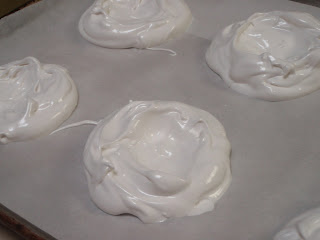But I suppose that as far as foods go, bread isn't really at the top of the "romance" list.
This is, of course, from "Consumer Reports"- the independent/nonprofit magazine that publishes information on products it has tested for the public to bolster a more "fair" marketplace. It's actually pretty interesting... you can check out information on varied products such as cars, wine, toasters, GPS, paint, cell phones, and shower heads. I wonder if Ralph Nader subscribes? Maybe he doesn't need to... I bet he already knows everything.
Anyway, this is a bread that came from the magazine a forever long time ago.
They were testing white bread, of course, but they said that if you really wanted the best bread you should just make it yourself.
Mom did just that. She made bread. It's been the go-to bread recipe since somewhere between 1983 and 1985.
Since it makes 2 loaves, we usually do a cinnamon raisin bread variation with one of the loaves (sometimes both). It's like a giant cinnamon roll and usually disappears quickly!
I actually substituted one cup of AP flour for whole wheat this time. No problem, but I would not recommend substituting more than that as whole wheat has a different consistency than AP. Whole wheat is a heavier flour, which makes it more difficult for the yeast to cause it to rise. I think it's actually drier, too. The recipe isn't written for it, thus the non- recommendation for the full use of whole wheat in this instance, but a partial substitution is fine. It may also benefit from a longer rising time (I think I let these loaves rise an hour and a half each time).
Liquid temperatures are very important. If you have water that is too hot, you'll kill the yeast. If the milk/butter mixture is too hot, you'll kill the yeast. A thermometer is not necessary, but you will definitely want to feel any liquid before incorporating it with yeast OR yeast with it. Something around body temperature is what you want- we can safely say 85-110 degrees. Not cold, but you probably wouldn't feel anything very warm- and definitely not hot.
"Consumer Reports" Bread
makes 2 loaves
1 pkg active dry yeast
3 T sugar
1/2 c lukewarm water (90 degrees)
3/4 c whole milk
1/2 stick (4 T) butter
1 1/2 t salt
1 large egg, beaten
4 c unbleached all-purpose flour
Place water in a small bowl. Dissolve yeast and 1 T sugar in water, set aside. Heat butter in milk until butter is melted, set aside to cool slightly.
Measure 2 T sugar and salt into a large bowl. Blend with a wooden spoon or spatula to combine. Add egg and 1/2 c flour and stir to combine. Stir in yeast and mix well (the mixture may be a little lumpy with the egg, but it will smooth out later). Add 1/2 c flour and warm butter and milk mixture and blend together. Add remaining flour (3 c) and stir to incorporate. The mixture may be slightly shaggy, at this point use your hands to knead a few times in to bowl until it comes together. Shape into a ball, oil or butter the top, and cover with plastic wrap or waxed paper as well as a towel. Place the bowl in a warm place (100-110 degrees) for about an hour, until doubled (sunny window, near the stove if you are cooking, on the porch in the summer as long as you aren't worried about wayward animals).
When doubled, punch down and knead. Divide dough in two and place in well-greased loaf pans (OR follow Cinnamon Raisin Bread variation below). Brush with softened butter, cover once again with plastic wrap and a towel and place in a warm location. Let rise until doubled (about an hour).
Preheat oven to 400 degrees. Bake loaves 20-30 minutes, until well browned and when bread makes a hollow sound when tapped.
Let cool in pans about 10 minutes, then remove loaves from pans to wire rack to cool completely.
Cinnamon Raisin Bread variation:
For each loaf of bread mix 1/3-1/2 c sugar with 1 t ground cinnamon (or to taste).
Roll 1/2 recipe of dough out onto clean surface into an approximately 9x12 inch rectangle. Don't use extra flour if you don't need it- the dough should be slightly tacky in texture. You want the dough to stick to itself when you roll it up.
Spread approximately 1/2 c raisins onto dough and sprinkle with cinnamon sugar. Leave approximately 1 cm border without sugar on both of the long sides and the far short side. Leave approximately 1 1/2 inches of sugar-free dough at the short side closest to you smooth the seam a little to make sure the dough sticks to itself. Starting at the far short side, roll the dough as tightly as possible. Pinch and fold the ends so that raisins and sugar doesn't spill out and place the bread seam side down in a buttered loaf pan. Continue with recipe as written.














































